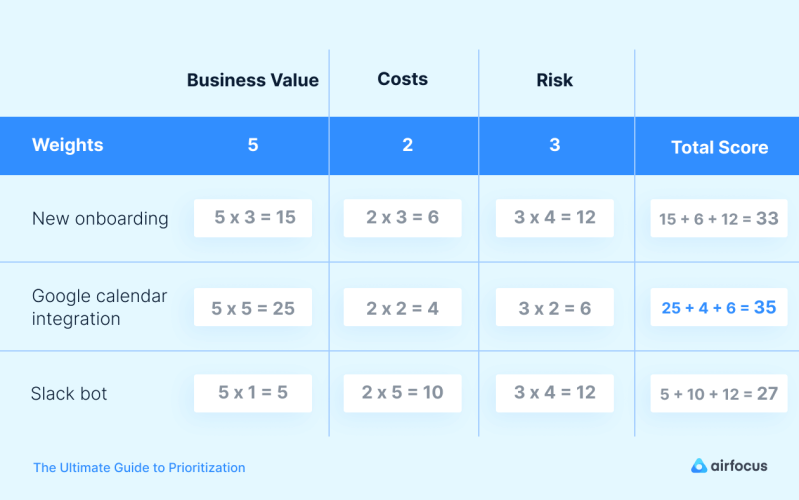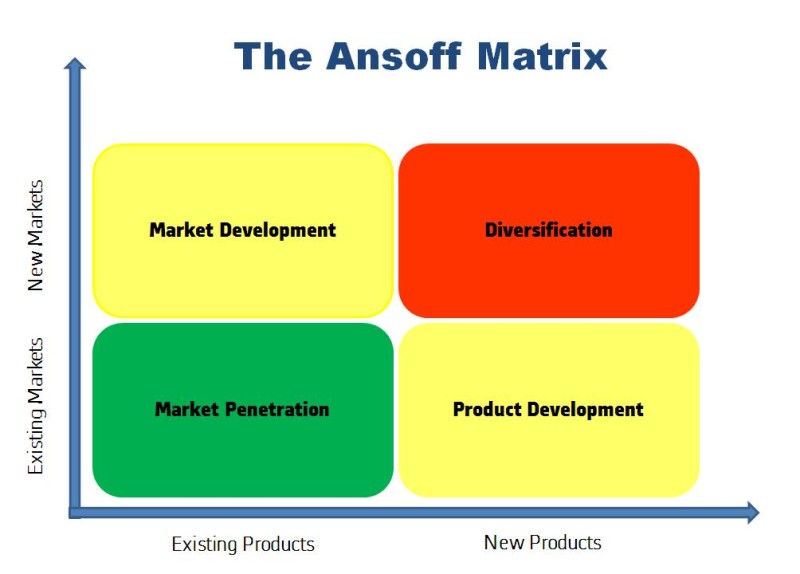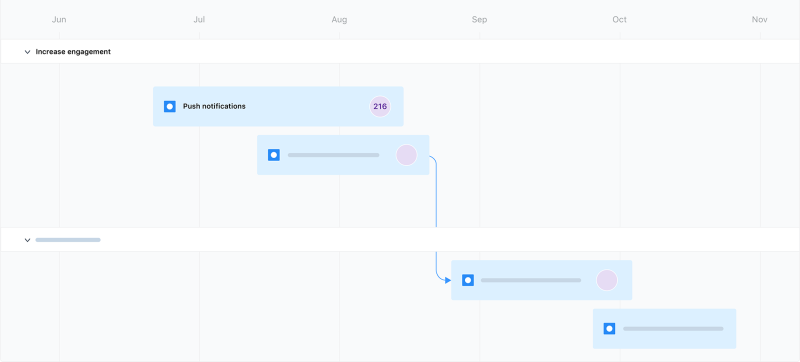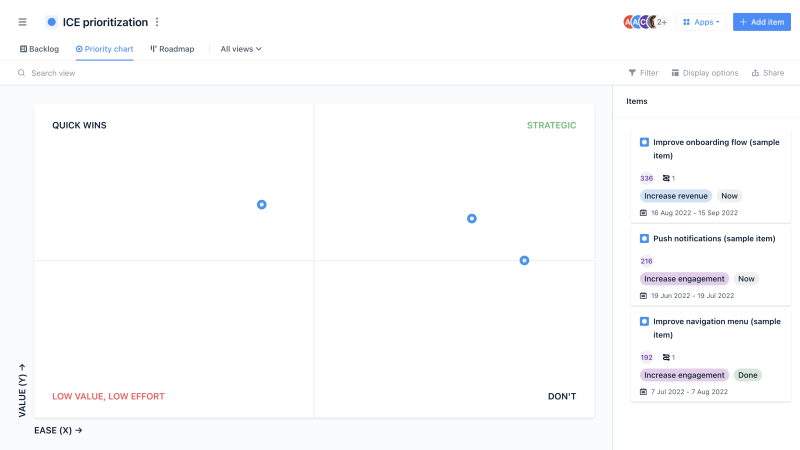3 Killer Prioritization Techniques for Building a Great Marketing Strategy

Having a high-level marketing strategy, the right budget, and the right team, isn't enough to ensure that you'll succeed.
Why?
Because it's also really important to make sure you have the most effective ideas to help you achieve your goals.
Remember, the Pareto Principle means 80% of revenue comes from just 20% of your efforts.
If your marketing strategy isn't succeeding in blasting your product into space, it's time to re-evaluate, rank your marketing activities, and transform your existing marketing strategy into an outstanding one!
Say hello to the three of the best prioritization methods for ranking your marketing activities and delivering revenue.
At the end of this article, you'll know exactly which tried and tested techniques will boost your marketing funnel, and you'll get ready-to-use templates and tools to make the right decisions.
Why is market prioritization important?
Few things in professional life are more frustrating than carefully planning a marketing campaign only to launch it and see it fizzle rather than explode.
As we’ve explored, there can be multiple explanations for this, but a lack of market prioritization doesn’t have to be one of them.
Market prioritization helps organizations identify the most valuable market segments based on size, growth potential, competition, and profitability. They can then allocate their resources effectively to meet the needs of those markets. Prioritizing markets in this way enables companies identify potential customers, tailor their product or service offerings, and ultimately (and most importantly) boost their bottom line.
Market prioritization isn’t necessarily a straightforward task — it requires identifying and focusing on the most significant opportunities and avoiding distractions that may siphon resources from existing markets. It’s also a process that requires a deep understanding of the target markets and customer needs and a willingness to adjust strategies as market conditions change.
Put simply: it’s about being agile.
Build a prioritization framework for your professional marketing strategy
You can create your prioritization strategy from scratch, or you can take inspiration from a decision matrix that's already been proved to be successful.
Here, I'll show you the best methods of doing just that by using airfocus and its built-in prioritization templates.
What's more, you can tailor these ready-made templates to your own marketing strategy needs at any time.
Because market prioritization is quite a broad concept, there’s no single “right” way to do it. With that in mind, let’s look at three specific frameworks your organization may choose to leverage to make market prioritization easier.
The Weighted Scoring method
Weighted scoring is very popular and one of the most effective ways of prioritizing marketing ideas. It can be a solid and powerful way to make decisions when you can weigh certain criteria, e.g., based on existing data or market research, and you can use weighted scoring to guide you through the jungle of data.
It covers almost every business need.
Prioritizing based on data gives you bulletproof decisions.

This method ranks your ideas based on predefined criteria, i.e., your current core marketing goals. Here are some examples:
Business value criteria
Lead generation - you can score an idea on how effective it can be at generating leads. You probably can't estimate all the leads you will get, but you can rank the potential number of leads on a scale of 1 to 10.
Brand awareness - don't be scared to e put a score on brand awareness. By using the predefined T-Shirt sizes (S - M - L - XL), as shown below, this ranking is super-easy to find out.
Effort
Project days - a marketing team's capacity is limited and highly valuable. Therefore the time period within which the ideas should be ranked is crucial.
Costs - not only is the team's capacity limited the budget could also be tight, so monetizing ideas is vital too.
This method calculates the score by using the following formula:
w1 x C1 + w2 x C2 + … wn x Cn = Weighted Score
Where "w" refers to the weight of criteria, and "C" refers to the criteria. Find out more about the weighted scoring method.
The formula used for this template is:
30% x Lead Generation + 20% x Brand Awareness + 25% x Project Hours + 25% x Costs = Weighted Score
You can change the weighting at any time to adapt it to your specific needs.
When scoring the criteria, airfocus shows an overall score as a result of the ranking process. This method is called weighted scoring because the impact of each criterion can mean that they rank differently. The predefined weights of the four criteria are equivalent by default, but you can modify them anytime.
The LICE method
If the weighted scoring feels a bit complicated at first, don't worry. If you're looking for an easier method, you'll like the LICE method.
This one does a great job when a marketing team needs to test brand new channels, and we have to thank Baremetrics for introducing this solid method.
This method works with two values and two effort criteria to score.
But, the only thing you need to do is rank these criteria on the same scale, e.g., 1-10 or T-Shirt size scale.

Lead Quality - you should look behind the numbers. Your marketing strategy could easily underdeliver if you focus only on the number of leads. Different marketing channels deliver different quality leads. For example, a lead from the "request a demo" page converts a thousand times better than a page on which users can download your free ebook. You can differentiate leads based on knowledge level, too - for example, experienced users might engage with your tool easier, and beginners, on the other hand, might need to be educated. The higher the points, the better the quality of the lead.
Impact - The previous criterion is about quality, but the impact score tries to estimate the quantity. For example, you can differentiate between the results of publishing an article on TechCrunch and publishing a guest post on a small blog by awarding 10 points to tasks with the highest impact.
Cost - if you struggled with estimating costs, then you'll definitely enjoy the fact that you can score everything on a scale of 1-10, where 1 point means the cheapest solution.
Effort - effort can represent all the non-monetized costs needed to launch a new experiment, regardless of whether you want to deal with project hours or project days. Score this in a similar way to costs.
This method calculates the score according to the formula:
Lead Quality + Impact + Cost + Effort = LICE Score
The prioritization for this is the same as before. After scoring the four criteria, airfocus summarizes the values and shows a focus score.
This method provides an easy environment for making decisions and building a marketing strategy, and you can set up the framework with just a few clicks by picking up the LICE method when you set up the board.
LICE can easily be performed on an excel sheet. Still, to prevent decision paralysis, we recommend using a dedicated tool with LICE templates, where you can collect your team’s ideas and integrate other tools to weigh them objectively together. The beauty of this is that you can choose how to weigh the different criteria that makeup LICE.
Below you will find the steps to carry out the LICE method:
Step 1. List all your possible marketing channels and ideas as your rows and your Lead Quality, Impact, Cost, and Effort as columns, and assign estimated values to the different ideas.
Using a 1-10 scale across criteria will make your life a lot easier. If you choose a dedicated tool, you can also use T-shirt sizes to make it even easier and avoid formulas.
Note: You can also customize the weight of the different criteria depending on what you consider to be most impactful.
For some, the effort might be a more impactful criterion than cost or vice versa.
Step 2. Calculate total scores by adding them up across columns, keeping into account that the cost and effort criteria are negative - Therefore, lower values in these criteria are regarded as better.
Keep in mind: If you assigned the criteria different weights (or multipliers), your calculation would look like the weighted scoring one: w1 x C1 + w2 x C2 + … wn x Cn = LICE.
Step 3. Compare scores and determine which channels and ideas are most worthy of pursuing.
While performing this on a spreadsheet can be easy, your team might want to visualize the scores on an axis to determine quick wins, strategic ideas, “do it later” projects, and items to cut, which can be visualized on a dedicated tool like airfocus.
The Ansoff Matrix
This framework is essentially a strategic planning tool that helps organizations identify potential growth opportunities based on four different strategies:
Market penetration: Selling existing products in existing markets
Market development: Selling existing products in new markets
Product development: Developing new products for existing markets
Diversification: Developing new products in new markets
So where does the ‘matrix’ part come in? Each strategy above is mapped onto a 2x2 grid, forming four quadrants. Each quadrant listed above is a strategy companies can pursue to increase their market share and revenue across new markets. The Ansoff Matrix offers a simple way to visualize your market prioritization.

The BCG Growth-Share Matrix
The Boston Consulting Group (BCG) Growth-Share Matrix is a portfolio analysis tool that helps organizations assess their product portfolio and allocate resources based on market growth and market share.
Similarly to the Ansoff Matrix above, this framework also uses four quadrants. This time, the matrix categorizes products into four categories:
Stars: Products with high market share in high-growth markets.
Cash Cows: Products with high market share but in low-growth markets.
Question Marks: Products with low market share but high market growth potential.
Dogs: Products with low market share and low market growth
The MPM (Market Prioritization Matrix)
The MPM is a modified version of the GE-McKinsey matrix developed by Notion for SaaS companies. This framework helps businesses prioritize their target markets based on market attractiveness and competitive position.
Once again – and this is becoming a trend, right? – the matrix has four quadrants:
High Growth: Markets with high growth potential and low competition
High Potential: Markets with high growth potential and high competition
Competitive Challenge: Markets with low growth potential and high competition
Not Worth It: Markets with low growth potential and low competition
The ICE method
If you want to use the most lightweight solution for collecting the right ideas for your killer strategy, then the ICE method is the one for you. The ICE method is a good choice if you want to see a high-level priority order.
The ICE method works with just three criteria.

Impact - points to how effectively you can influence the targeted result, where the higher value indicates that these ideas will have a bigger impact on the result.
Confidence - shows the probability that this activity will lead to the degree of improvement you set in impact. To keep confidence scores consistent, you should predefine the values. For example, score it from 1 to 3 when it's a feeling instead of a data-backed idea or 4-7 if you run a test, etc.
Ease - summarizes all the effort used in the previous methods no matter what your team's weak point is (budget or labor capacity). Score it on a scale from 1 to 10, where the activity that ranks number 10 points is the easiest and quickest activity to implement.

This method calculates the score according to the formula:
Impact x Confidence x Ease = ICE Score
Tasks with the highest ICE score have the highest priority.
The general argument against the ICE method is that some people think it can be too subjective. However, you can easily avoid it becoming too subjective by using the following tips:
Declare a general meaning for each criterion/value, e.g., score "Ease" from 8 to 11 when it could be delivered in 5 business days; 5 to 7 when it needs two weeks, etc. Then, create a cheat sheet from these values and use it when prioritizing.
Use the team's input, discuss all the ideas in a prioritization session and combine these benefits with the formerly described cheat sheet.
Work in short iterations - score all the ideas, then re-prioritize the remaining tasks after the first iteration - so the team/marketer can learn and prioritize wisely.
You can easily refine the ICE method by adding new criteria; moreover, it can be upgraded to the Weighted Scoring method by splitting the "Ease" criteria into "Cost" and "Effort." Using airfocus you can insert new criteria with just a few clicks.
I recommend you prioritize using the ICE method for a while, at least whilst you don't have enough data or learnings to give accurate estimations. Try to log and note all of the efforts, especially labor costs, e.g., It's hard to predict how long it takes to compile blog posts before you have done a couple in a specific field or for a specific customer.
Revise your data
investigate revenues: how many leads can be generated by a channel, by an article, by a campaign?
try to monetize costs, e.g., content: working hours, guest writer, proofing, images, etc
Don’t just rate tasks, test ideas
We are all familiar with testing ideas. But perhaps there’s a step you’ll want to take before doing so to reduce risks.
Much like prioritizing tasks, you might be on the fence about a group of ideas you’d like to test out, yet you aren’t completely certain. Using the ICE approach will use gravity to visualize which ideas are true winners, or your lowest hanging fruit, and which sink and you should cut.
Easily put ICE into practice
Ice is one of the easiest ways to work out what ideas your team should be pursuing and can be done on a spreadsheet or a dedicated prioritization tool in a few simple steps as outlined below.
Step 1. List all the possible ideas as rows, and Impact, Confidence, and Ease, as columns.
Step 2. Rate each choice for each criterion
Evaluate your different choices against the criteria. For each of these values, you have to make sure that higher values represent more favorable options from 1 to 10.
Keep in mind that for impact, you’ll want to consider factors that move the needle for customers and growth drivers across acquisition, activation, retention, referral, and overall revenue. For confidence, your best bet is to use a 1-10 scale on a spreadsheet.
Lastly, for ease, you’ll want to consider that 10 represents your easiest and least time-consuming task.
Step 3. Multiply values across, and determine scores.
As simple as it sounds, multiply impact by confidence by the ease and get a final score.
Step 4. Make your decision.
Your highest score will be indicative of your highest priority most of the time.
In practice, ICE’s simplicity can also be sometimes regarded as its Achilles’ heel (but it doesn’t have to be), as it focuses on how important the criteria of a task is relative to its higher-level goal.
That’s why working out the score is only the beginning.
In marketing, speed and awareness are important assets, so you should always know how your content and efforts are interconnected and how some lower-scoring tasks might take precedence over higher-scoring ones at times.
Therefore, you should get a detailed overview of your team's tasks within campaigns and overall goals.
This can be done immediately with a dedicated tool using a chart view, where you could spot if you’ve overlooked low-hanging fruit or might want to time larger strategic tasks differently.
Pair this with the timeline view and place the tasks exactly where they need to be, with full attention to possible dependencies.
Determine the right marketing channel mix using templates
Working out the right strategy can be simpler than you previously thought. Now that you understand what market prioritization is and how you can leverage frameworks to assist in the process, how do you know which one to choose?
To answer this, let’s consider a few different marketing initiatives and which market prioritization framework would be best to leverage with them:
Launch a social media campaign: Low effort, high feasibility, medium impact
Develop a content marketing strategy: Medium effort, high feasibility, medium impact
Conduct customer research surveys: Medium effort, medium feasibility, high impact
Launch co-marketing campaigns with complementary organizations: High effort, medium feasibility, high impact
So which framework would be best to apply to this list of marketing initiatives?
While they all offer some utility here, the Ansoff Matrix is the most relevant and useful. These initiatives are focused on identifying new markets, expanding existing products, and exploring new market potential — fertile ground for the Ansoff Matrix and its focus on growth opportunities.
For quick reference, here’s a quick rundown of situations where each of the frameworks above would come in most useful for market prioritization:
The Ansoff Matrix is useful during the marketing planning phase, particularly for identifying new markets, exploring new opportunities for existing products, and evaluating potential growth strategies.
The BCG Matrix is handy for conducting a comprehensive audit of your existing product portfolio, assessing each product’s long-term potential, and making strategic decisions about how best to direct resources.
The MPM is ideal when you want to streamline your focus towards a smaller set of priorities, products, or markets, enhance your efforts' effectiveness, and maximize your ROI.

To sum up, useless activities could kill your growth, or even worse, your company. Therefore making the right decisions is critical.
You should know which are the most promising, up-and-coming projects. A solid prioritization method works wonders for your marketing strategy by selecting the most valuable activities from a potential crowd of marketing ideas.
If you don't want to create a marketing prioritization framework from scratch, try a ready-to-use airfocus template and integrate it into your existing workflow seamlessly.
This enables you to visually map your marketing priorities on a chart and transform them into an actionable roadmap at the click of a button and share it with your stakeholders.
How to build a prioritization framework
To set up the framework, avoid the inefficient and time-consuming options. Manage the scoring in airfocus to:
save time on building a prioritization framework
boost productivity by adding collaborative features such as comments
keep the crucial data in one place using details and attachments
push all the discussed and scored items into your project management tool with a single click (Trello, Asana, MS Planner, GitHub, or JIRA)
Unlike old-school solutions, you can integrate prioritization and decision-making processes seamlessly into your existing workflow. As well as the collaborative features, there is a proper decision matrix where the ideas can be visualized. The value-effort chart provides an intuitive spot to choose the right ideas to execute.
The weighted scoring fits for all business needs and has benefits, especially when you:
have too many competing ideas
are working in a big team
have enough data for a hyper-accurate estimation
Best Practices for market prioritization
Involve key stakeholders. Involve all stakeholders in the prioritization process, including Sales, Marketing, Product, and any C-suite members. This helps ensure buy-in and alignment across the organization — and avoids any nasty surprises.
Use data to inform decision-making. Data-driven insights are a powerful tool for identifying high-potential markets, customer needs, and competitive trends. Using them correctly helps prioritize markets most likely to generate revenue and align with the organization's long-term goals.
Prioritize regularly. Prioritization is one of those processes that, once started, never really ends. To stay agile, regularly evaluate and adjust your priorities based on changing market conditions, customer feedback, and business objectives.
Leverage customer feedback. Direct feedback from your target customer is like gold dust. It can help identify new opportunities, inform product development, and improve overall customer satisfaction.
Know your competitors. Keeping an eye on your competitors is always a smart play. Not just that, but truly understanding their strengths and weaknesses is essential. Prioritize initiatives that differentiate your products or services and capitalize on your organization’s unique strengths.
Be open to new opportunities. Never close yourself off from exploring new markets, customer segments, or product ideas. Prioritize initiatives that have the potential to create new revenue streams and drive growth — wherever they may come from.
Don’t be afraid to abandon products or markets that aren't working. Sometimes, things just don’t work. Accept that. Prioritize initiatives that address underperforming areas and be open to abandoning products or markets that aren’t generating the desired results.
Use the right tools. Using the right tool for the right job is essential. By leveraging smart tools like airfocus to help prioritize your process, you can effectively facilitate market prioritization, ensure consistency across the board, and reduce that all-important time-to-market.
Valentin Firak

Read also





Prioritize with confidence

Experience the new way of doing product management



